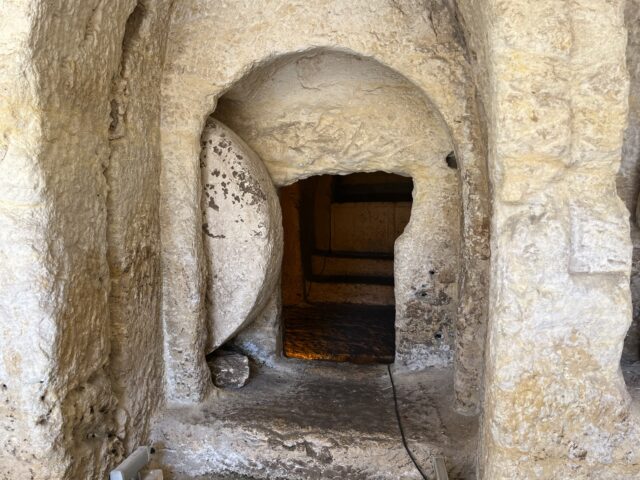By Frank van Steenbergen
The Kizilkoyun funerary in ancient Urfa has 133 burial chambers carved into the limestone rock. The tombs were developed in the first two centuries after Christ, housing the graves of early Christian and Jewish families in what then was called Edessa.
Over time the graves were emptied, though in some of the burial chambers the sarcophagi and stone beds remained. The caves became inhabited over time and in the mid of the 20th century there were 400 houses inside the funerary complex. There is a second funerary complex nearby: Bedüzzaman. In the latter part of the last century all houses were removed from this funeraries and the burial caves were restored of all human habitation.

Though the Kizilkoyun funerary now appear ravaged by time, it looked very different in its hey day. Edessa was an important Christian city and the exterior of the graves will have been ornately decorated with sculptures. Inside the graves mosaic floors with Arameic/ Syriac text may have been adorned with mosaics with funeral portraits, as recently discovered in one of the tombs in Bedüzzaman.
At present only one of the burial caves in Kizilkoyun has survived with all images. It entrance is a lime stone door and in the arch above there is an oyster and two weathered images that may be the Virgin Mary and John the Baptist. The oyster stands for Jesus, the singlemost beautiful pearl of all, immaculately conceived and purity born out of living being, as in in Matthew 16: 45-46..The oyster also stands for the shelter and the protection of the inner world against the outer world. The shell is also the symbol of baptism, being immersed and then reborn in Christ as a new person with all sins forgiven.
The grave next to it has a door as well. It is not square, but It is a spectacular stone circle door. Many caves in the Kizilkoyun funerary had such doors but only this one is intact. Inside there is an empty stone bench. Nothing comes closer to what is written of the resurrection of Jesus, after his body had been taken from the cross and laid to rest in the grave chamber of Josef Aramea.

1Now upon the first day of the week, very early in the morning, they came unto the grave, bringing oil and spices which they had prepared. When they arrived they and they found the stone rolled away from the grave. And they entered in, and found not the body of the Lord Jesus, but found his cloth folded on the bed. As they were much perplexed, two men stood by them in shining garments: And as they were afraid, and bowed down their faces to the earth, they said unto them, Why do you seek the living among the dead? (Luke 24: 1-12).
Note: This is one in a series of blog articles on biblical events and their links to land, soil and water management in Turkey. You can access the other blogs of this series via the below links:
Choosing the Ice Lake – the 40 Martyrs



